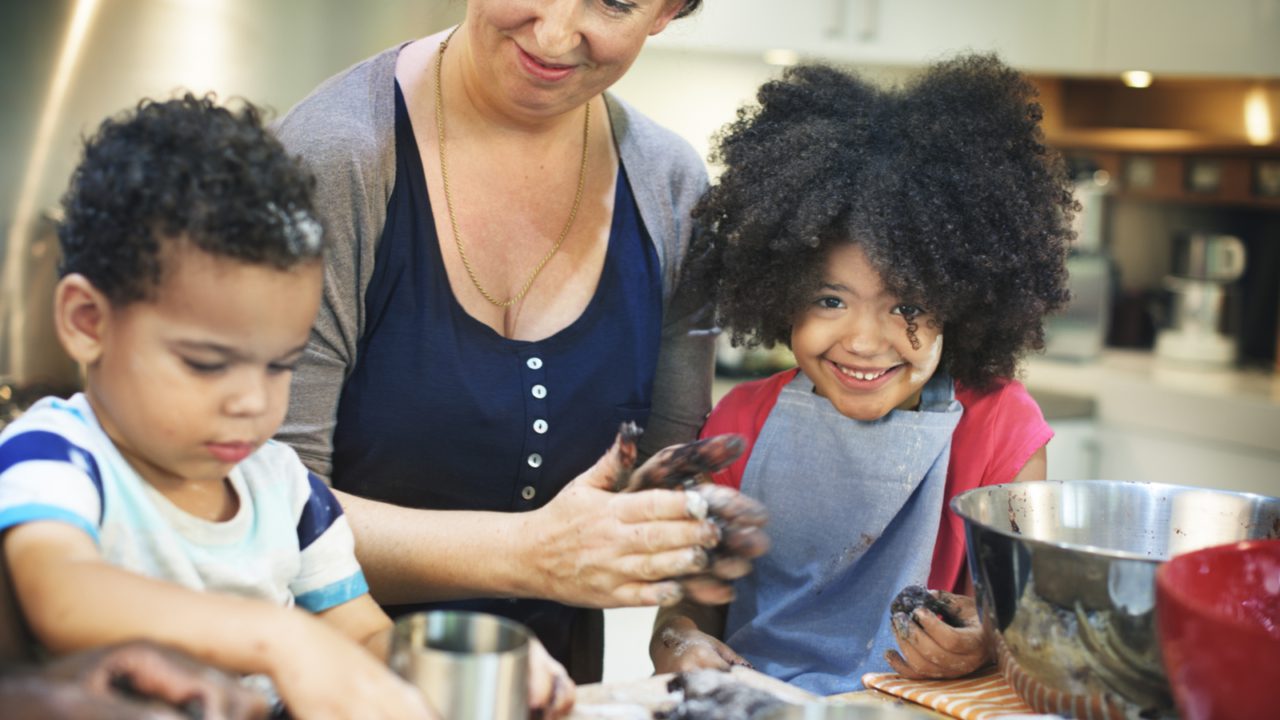These parent-child activities help young children develop self-confidence and self-esteem.
IN THIS RESOURCE
Gather Round activities are designed to help families promote their child’s language and literacy skills while also nurturing the other domains of development (thinking, language and communication, social-emotional, and physical skills). A children’s book is suggested for each topic area and age (birth to 12 months, 12–24 months, and 24–36 months) along with activities related to the book based on a range of developmental domains and early skills. The activities can be used with parents as a tool to promote children’s learning through book-sharing and age-appropriate parent-child activities.
Birth to 12 Months
Book:
I Love You Through and Through by Bernadette Rosetti Shustak
Publisher: Cartwheel
Activities that build on the ideas in I Love You Through and Through
1. Play in-and-out with a laundry basket. Hold your baby outside the basket and say, “I love you when you’re outside” (Kiss!). Then pick him up and gently place him inside the basket: “And I love you when you’re inside, too.” (Kiss!) Not only will your baby be having fun, but over time, this helps teach the meaning of in and out.
2. Make a book with pictures from magazines of babies showing a range of emotions: happy, sad, surprised, angry, and so on. Glue each photo to a piece of sturdy cardboard or an index card and tie or staple them together. Then, as you show your baby the pictures, name each emotion: “This baby is happy. He is smiling.” Helping young children understand and label their emotions is an important social skill.
3. Hold your baby in front of a child-safe mirror and point out her eyes, nose, mouth, and more. Label what each body part is. Talk about how cute and loved your baby is. Then lean in and give her a big hug. Although your baby doesn’t know it’s her in the mirror, activities like this will help her understand that she is separate from others and develop self-awareness.
4. This story talks about how parents love their babies’ different body parts. You can help your baby understand that his body belongs to him by playing “This Little Piggy” with his toes or “Where Is Thumbkin” with his fingers. Plus, this special one-on-one time shared by you and your baby builds a sense of loving connection between the two of you.
5. While your baby is in the bath, gently pour water over her toes: “Do you feel the water on your toes?” Then pause and see if she opens her eyes wide, kicks her legs, or makes a sound to tell you, “Keep going!” Try pouring water over her hands, belly, arms, shoulder, and head (try to avoid pouring water in her eyes). Over time, gentle games like this help your baby learn her different body parts—and that baths are lots of fun!
12–24 Months
Book:
Hush Little Baby by Sylvia Long
Publisher: Chronicle Books
Activities that build on the ideas in Hush Little Baby
1. Play ball! Take turns rolling it back and forth with your child. Give your little one a chance to “run like anything” (just like in the story) to catch the ball. Play basketball by having your child run to put the ball in a basket or box, or bowl by rolling the ball to knock down five “pins” (actually empty plastic bottles). Toddlers have great fun putting all their growing physical skills to work.
2. Your child’s sense of self-confidence and self-esteem grow when he sees how much pleasure you get from spending time with him. Take some inspiration from the illustrations in this book and go outside one evening to look at the moon and stars. Being held by you, surrounded by the quiet night sky, will be a special and loving experience for your child.
3. The parent in this story uses a very loving bedtime routine for her baby bunny—including a period of quiet play, a story, song, a teddy bear, tucking in, and a kiss good night. One night, take a photo of your child during each step of her bedtime routine. Glue each photo to an index card and hang these on the wall of her room at her eye level. As you get ready for bed, show your child (using the pictures) how you are progressing through her bedtime routine. This helps her know what to expect, which will make her feel safe, secure, and confident about herself and the world around her.
4. Using a doll or stuffed animal, play “night-night” with your toddler. Show him how he can lay the baby down in a shoebox “crib,” put a blanket (or washcloth/dish towel) over the baby, and say, “Night-night.” Games like this help your toddler learn to sequence events—or put them in order—and also teaches your child to be a loving caregiver…just like you!
5. Children feel confident and develop good self-esteem when they are allowed to have some “say” about their daily routine. As your child nears 2 years old, offer her choices within limits—this means that (1) you decide what choices your child is allowed to make and (2) all the choices you offer are acceptable to you. For example, your child doesn’t get to choose whether she brushes his teeth, but she can choose to do it before or after book-reading time. During your child’s bedtime routine, offer two choices for a quiet game before bed or a choice of which stuffed animal to cuddle at night. She can even make silly choices, like whether to have a kiss on her cheek or her forehead.
24–36 Months
Book:
“More, More, More,” Said the Baby by Vera B. Williams
Publisher: Greenwillow Books
Activities that build on the ideas in “More, More, More,” Said the Baby
1. This story is all about the fun that “little” people have with their “big” people. Help your toddler learn the concepts of “big” and “little” by cutting big and little circles, squares, and triangles out of sturdy cardboard. Feel free to paint or color them, but keep the pairs (big circle and little circle, for example) the same color. Show your child the shapes and label each one as “big” or “little.” See if your toddler wants to sort the shapes by “big” and “little” and then by “circle,” “square,” and “triangle.”
2. Use the story to get ideas for ways you can show your toddler how much you love every little part of him. Swing him gently and give him a hug while telling him how much you love his little belly button. Or hold him nose-to-nose, bounce him on your knee, and tell him how much you love his toes—every single one! These moments with you make your child feel loved and special.
3. Create a photo book of your child and all of the people who love her. Under each photo, write down something each person has told you that makes your child special. Nurturing these loving connections between your child and her family and friends helps her know how much she is loved.
4. Toddlers enjoy feeling that they are a contributing part of their families. You can help your toddler develop self-esteem by giving him an age-appropriate opportunity to contribute to the family. Your child can help you put clothes in the laundry basket, wipe the table with a sponge, or even sweep the floor. Of course, toddlers won’t do these jobs perfectly, but they are learning that it feels good to help out.
5. Take some inspiration from this story, where the grown-ups have lots of active fun with their “little ones.” Go outside and ask your child to lie down on the sidewalk or driveway while you trace her outline in chalk. Then you lie down and give your toddler a chance to trace your body. Decorate your outlines with chalk. Ask your child if he can find his outline and your outline. Which one is big? Which one is little?




